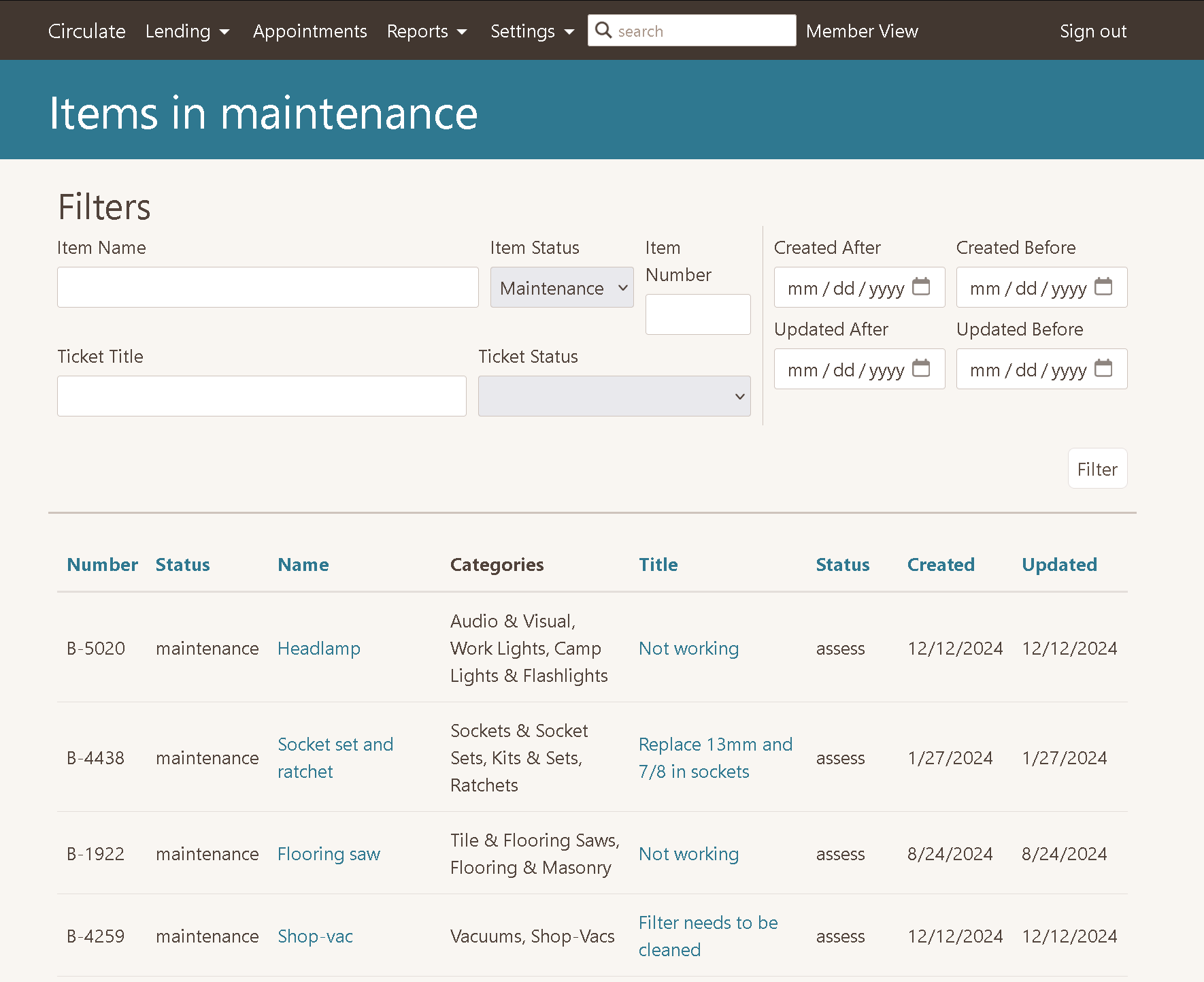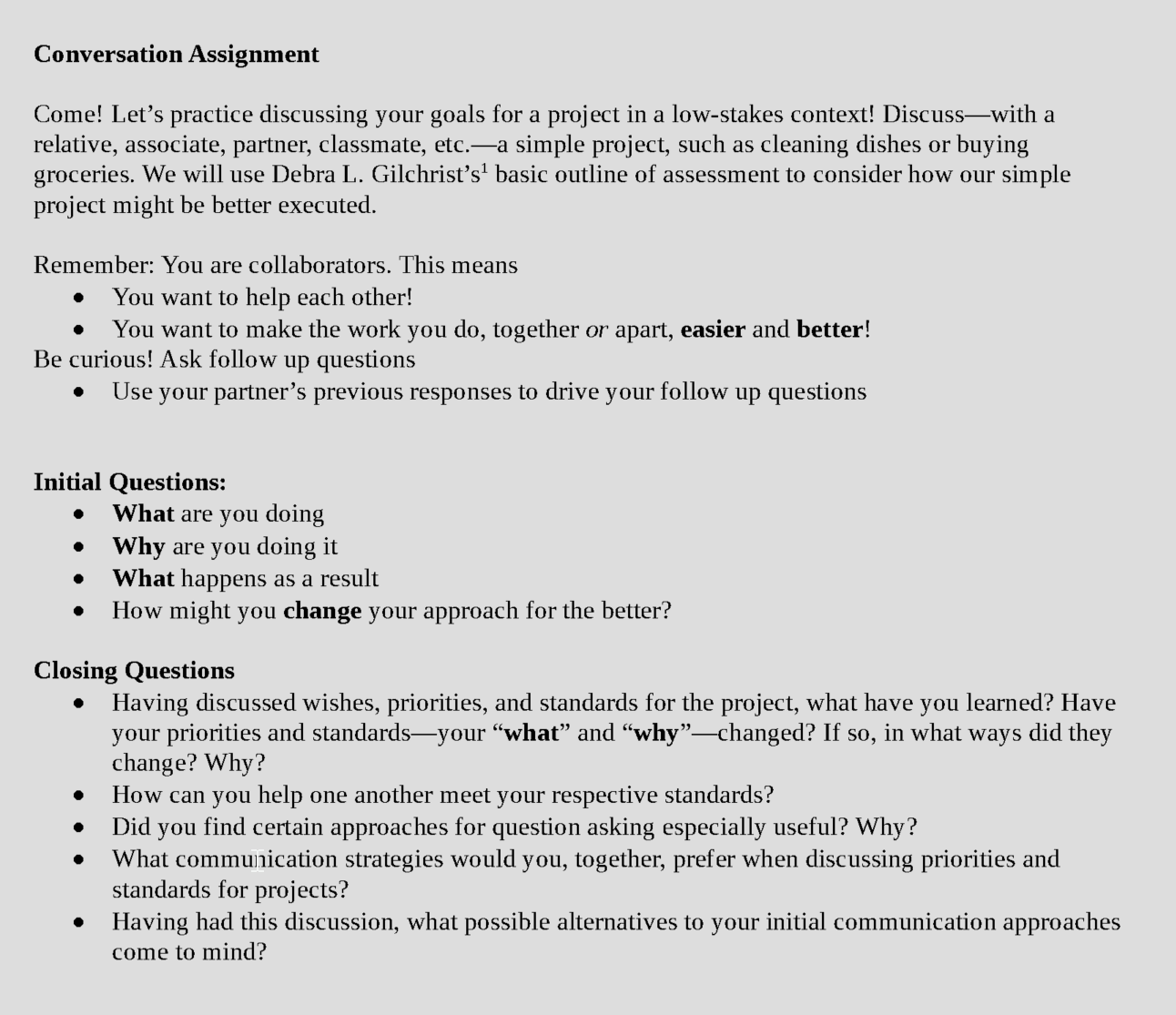This is Drew's Portfolio.
I studied for an MA of Library and Information Science (LIS) through the University of Arizona's online grad program. Here are a few things I worked on during that program:
Maintenance Report & SQL Query
course: LIS 698 - Capstone Internship
reflection: During my internship I helped redesign a report for maintenance tickets in the Chicago Tool Library's catalog/admin software Circulate. Part of that work included composing a SQL query upon which we could base the report, shown in the following block of code. This was a delightful exercise in building a database query. It gave me the opportunity to pracitce basic techniques as well as some fiddly language-specific work to get PostgreSQL to concatenate a column that returned multiple results. (You can see those results in the "Category" column of the report.) I also spent time with staff and volunteers involved in collection maintenance to determine other helpful features for the report, such as sorting and filtering by column.
material:

SELECT
items.number, items.status, items.name,
string_agg(categories.name, ', ' ORDER BY categories.name) AS categories,
tickets.title, tickets.status, tickets.created_at, tickets.updated_at
FROM "tickets"
JOIN "items"
ON tickets.item_id=items.id
JOIN "categorizations"
ON items.id=categorizations.categorized_id
JOIN "categories"
ON categorizations.category_id=categories.id
GROUP BY items.number, items.status, items.name, tickets.title, tickets.status, tickets.created_at, tickets.updated_at
ORDER BY tickets.created_at DESC
Practice Assignment
course: LIS 581 - Information Literacy Pedagogy
reflection: After a semester's worth of reflection on various teaching philosophies and practice defining our own, we were challenged to walk the walk and create an assignement that reflected our teaching philosophy. The assignment led us through the process of backwards design, which was such an excellent exercise in considering how your philosophy and goals as an instructor can manifest through the learning materials you make. I have never felt so confident that I could tweak and polish learning materials.
material:

Quilt Essay
course: LIS 541 - Preservation
reflection: One of the primary things that excited me at the start of my LIS studies was the idea of tending to books and other library materials. My semester before LIS 541, I took LIS 540 (Intro to Archives) and was dead set on finding the answer for the best and longest-lived material on which we could store knowledge.
The two courses repeatedly taught me that records take many different shapes, and that preservation similarly looks greatly different from case to case, and the nature of some information necessitates deliberately impermanent media for communicatoin. This essay is my coming to terms with some of the realities of preserving culture.
material: I've been thinking about quilts and when, or if, I want to worry about preserving them for a while. I suppose the answer, much like many answers to preservation questions, is not a simple "yes" or "no."
My partner comes from a family of quilters. She gave me a quilt as a birthday gift when we first started dating. I've helped her make at least one quilt every year since then, so that makes... 9-18 quilts? That's a pretty big range. To be perfectly honest, as a person who'd only made a handful of textile objects in my middle school sewing class, that might as well have been a million quilts. I guess this is all to say that living with a quilter has helped me learn to better appreciate just how much work goes into making a blanket!
That brings me to a question I often return to, which my partner often smiles at: "When do I lock this quilt up like the precious artifact it is?" I helped her make a giant quilt for playing or picnicking on when my brother's first son was born. My brother saw the quilt, looked at my partner, and said "I will not let anyone lay on this." My partner smiled and said, "I made it for people to use!"
Our house and the houses of my partner's relatives are full of quilts. They're bedspreads. They're folded in the backs of cars for picnicking. Some are even packed into baskets alongside the cheap fleece discount store blankets, to be used when someone gets a little chilly.
I read Harvey & Mahard (2020) this week with quilts in mind the whole time. I couldn't help but think about how so many of our quilts face each and every kind of possibly destructive exposure very regularly: water, dramatic temperature changes, physical strain, tight folding and packing. But after fretting over all this exposure I remembered that not every cultural object is for preserving indefinitely.
The quilt as a cultural object, at least in my recent experience, has been most appreciated as a project of frugal, use-minded textile craft. The quilt is a scrap pile given purpose.
Quilts give life to bits of fabric that cannot go anywhere else. They prolong the life of textile material in a different way. Not by locking fabric away under strict climate control, but understanding that, with a little structure and thought, odds and ends still have plenty of use value. The art of quilt making refuses to make garbage of textiles and instead creates a versatile layer of protection and warmth.